Welcome to The Old Republic: a massively multiplayer BioWare RPG based in the Star Wars universe. That means space opera plot, tough choices, and in all probability a lot of arguing with your asshole friends. Rather than follow the MMO template of pop-up quest text with little more than an ‘Accept’ button by way of interaction, BioWare Austin are giving you the kinds of major choices that have come to define their single-player games. The difference in The Old Republic is that you can take your friends with you and pause to chat about the big decisions before you make them.The game was first announced on October 21, 2008 at an invitation-only press event.
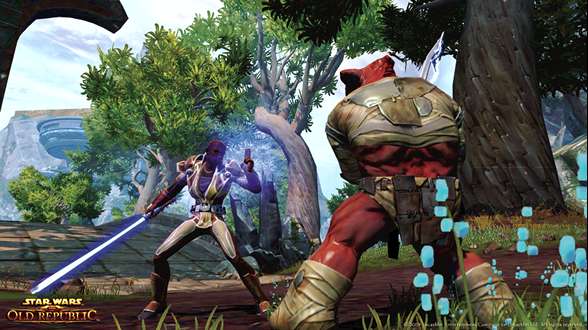
But this is more than just a cinematic RPG with extra players. This is a game on a scale BioWare have never attempted before. They’ve previously made their stories feel epic by hinting that there’s more going on in the universe around you, but this is the game where there actually is.
“It’s just such a huge game,” says James Olhen, creative director on the project. “It’s the biggest game I’ve ever worked on. I’m surprised at the enormity of it every other week… We’re creating more content than Mass Effect 2, Mass Effect 1, Dragon Age, and Knights of the Old Republic put together, and throw in Baldur’s Gate too.”
It’s so big that even a year from release it already has more recorded dialogue than the Mass Effect games combined. By the time it’s done, it’ll have more than the sum of all of BioWare’s 17 other games – James calls it “one of the most ambitious voiceover projects in the history of the videogame industry, perhaps of the entertainment industry itself.” It’s not so much the talking that’s exciting, though the cast list does include returning favourites from other BioWare games. It’s what that says about the sheer amount of stuff that will be available to do. Imagine a Knights of the Old Republic that lasted for as long as you cared to play it. Unless they screw it up, this will be BioWare’s magnum opus.

Yet it’s hard to see how such voice-acted, scripted, personal quests could fit with a massively multiplayer game. It’s tempting to imagine The Old Republic might be one of these pseudo-MMOs: Champions Online, for example, relies heavily on instances, creating multiple copies of busy zones that rarely contain more than 30 people at once. The Old Republic doesn’t work that way. “Our public areas are part of one contiguous world,” Olhen says. “Not just our cities – 90% of the game, actually, will be a public area where you can run into other players.” He says the number of players per server will be comparable to World of Warcraft’s, some of which are home to 30,000 players at once.
“We really want this to be a classic massively multiplayer game, and have that feel. We are using instancing to tell some of our more complex stories, but it’s definitely not going to feel like a heavily instanced game. The very personal missions that revolve around who you are and your class – they’ll take place in instances. But missions that are group-oriented, that you can do with your friends, those’ll take place in public areas.”
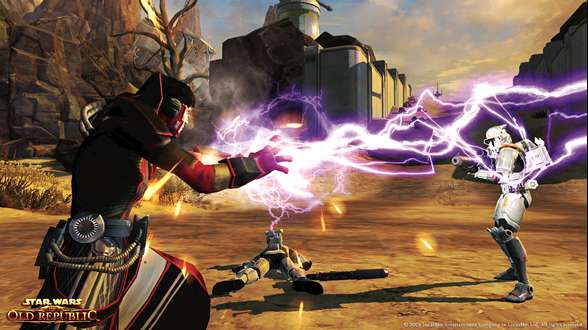
Neither type of quest will be like anything we’re used to in MMOs. Even the best-made of those know their little boxes of quest text aren’t engaging: World of Warcraft spelt them out line by line to force players not to skip them. Last year Blizzard’s own Jeff Kaplan announced at GDC: “Basically – and I’m speaking to the Blizzard guys in the back – we need to stop writing a f—ing book in our game, because nobody wants to read it.”
The Old Republic’s talky scenes will not only be voiced, but custom animated and cinematically directed like the best of BioWare’s single-player work. Their last game, Mass Effect 2, set a new standard in this both for BioWare and the industry at large. So it’s good to hear that the man principally responsible, lead cinematic designer Armando Troisi, has since moved to The Old Republic team.
“In other MMOs,” Olhen says, “a lot of the time, you just have designers who aren’t writers writing up a quest and coming up with the dialogue.” Olhen says. “And it shows, right? That’s probably the biggest change. High quality voice actors, writers, directors, editors – those are the things that haven’t been done. It’s huge for immersion, right? It’s not just getting a text bubble that comes up, it feels like you’re part of a movie. A non-player character feels like more of a real person living in this universe.”
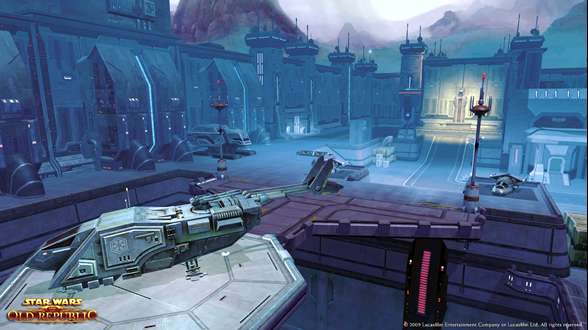
And it’s not just a single movie BioWare want to draw you into with The Old Republic: each of the eight classes has its own story, tailored to the role you’ve chosen to play in the world. It might take place thousands of years before they were born, but you’ll still be able to play rough analogues of Luke Skywalker (Jedi Knight), Han Solo (Smuggler), Darth Vader (Sith Warrior), Darth Maul (Sith Inquisitor), Yoda (Jedi Consular), Grand Moff Tarkin (Imperial Agent), Boba Fett (Bounty Hunter) or, er, a Republic Trooper (Republic Trooper).
“I was lead designer on Dragon Age before I came here,” says Olhen, “and a lot of the things from Dragon Age – like each origin having a separate storyline – we took that. And we took it even further: each class having their own story all the way through the game.”
So there is a main questline, but it’s personal. After all, if your mission was to vanquish the Sith, it’d make the other 29,999 players rather unhappy if you achieved it. These eight stories will give a profound new meaning to alts – the practice of starting a second character to try a different class. Here, it’ll be a different game in both play style and content.
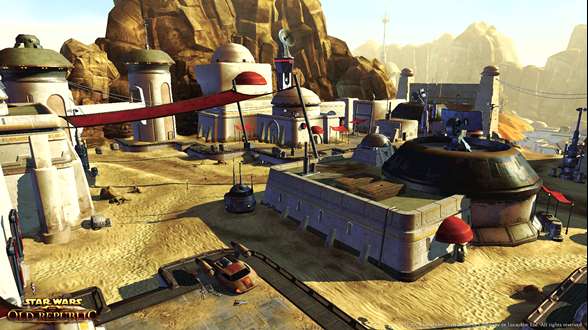
Something else we’re not used to in massively multiplayer games is having a computer-controlled party. As in other BioWare games, certain key characters you meet in your quest will be up for joining you. These are unique to your class: the Sith Inquisitor’s first friend is a Force-resistant warrior to help him fight Jedi, and we’re hoping the Han Solo-inspired Smuggler gets a Chewbacca-inspired chum.
“We introduce a companion character early on,” Olhen explains. “That’s your first. But then as you adventure, much like in any other BioWare game, you’re going to meet other interesting characters and they’re able to join your party.”
Eventually you’ll have a considerable roster of superfriends, but you can only have one at a time physically by your side. “When you arrive at one world, you might decide ‘Ah, I’ll adventure around with my wookiee because I really need someone who’s really strong and can take a lot of damage. Plus, I like my wookiee.’ But then on a different planet, you might decide to go with your femme fatale character, because you like the relationship that’s developing with her and you want to see what’s gonna happen, or you like the sarcastic comments she says, or because you want a DPS (high damage-per-second) companion.”
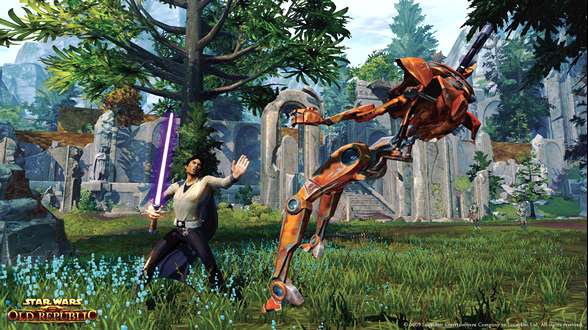
As in Mass Effect 2, your companion characters will have their own personal stories and quests that get you mixed up in them. And because they’re unique to your class, these can also tie in to your own storyline. The downside of this system is the same reason it’s not normally done in multiplayer games: you’re going to see other people running around with the same friend as you. “To take your Chewbacca example,” Olhen says, “if you run into a Smuggler, and he’s adventuring with his wookiee Chewbacca, yes, the stories of the two companion people will be the same, they’ll be doing the same interjections in your conversations.”
This, you will notice, is silly. “It was one of our concerns early on in design,” Olhen admits. “But you’re not going to have identical companion characters. We’re thinking of ways to make sure you can customise them so you don’t get confused, so you don’t get the Chewbaccas mixed up.”
When playing with friends of different classes, at least, it’s going to be fun jetting around the galaxy with your chosen AI pals. They’ll round out your team’s abilities and have things to contribute during conversations with NPCs. Since your real friends will also pipe up in these exchanges, they’ll start to feel more like scenes from films than the usual interview-like format of game dialogue.
In The Old Republic, your class determines your story, your voice, your companions and your abilities. But the latter aren’t completely decided by your initial choice: as you level up, you’ll come to a point where you have to make a key decision about your character’s future. You can evolve your skillset into one of two more specialised classes, suiting your character better to the way you prefer to play them.
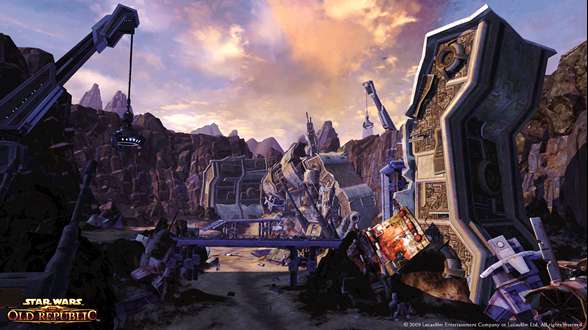
Olhen gives an example: “The Sith Inquisitor is the more agile rogue character: he doesn’t wear heavy armour, he’s much quicker, and when he gets to a certain level, he has to choose between two different paths. One path is more like Darth Maul, where you have the dual-bladed lightsaber and you’re all about acrobatic lightsaber moves. Or you can choose to do another path which is more of a ranged path, and more of a Emperor Palpatine path. You’re less about the lightsaber, more about the range and force powers.”
It’ll be nice to make such a major choice late in the game: usually we’re asked to make the biggest decision about our style of play before we have any real idea what it’s going to be like. And it won’t be your last opportunity, either. “Once you’ve made that choice, you still continue to make choices about how to customise your character from there… There are certain powers that you can unlock or have locked away from you as you level up.”
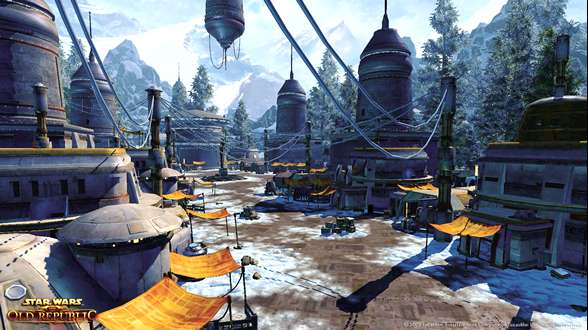
The biggest worry right now is presentation. The simplified visual style looks great for environments but rather ugly for the plastic-wigged, big-nosed characters. It’s presumably related to the sheer amount of content they have to create: more than their five biggest games put together, yet their team is “not a huge amount” larger than Mass Effect 2’s. “It’s not like we’re double,” Olhen says.
The Smuggler class can use a rudimentary cover system, but the others seem to stand in the open whittling people’s hitpoints down – like most MMOGs, but unlike other BioWare games. There’s a lengthy video of some normal play so you can judge for yourself whether this stuff is going to bother you.
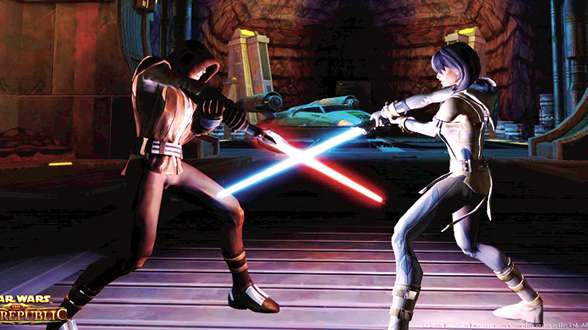
Since the game’s not due this year, BioWare are being careful about saying too much too soon. Olhen reckons that “Fighting and questing is going to be 90+% of what you’re doing,” but he’s vague about the other 10-%. “We’re going to have some open world PvP. As for the more structured PvP, I can’t go into details on that, but we will have it. We have talked about crafting, that’s something we are going to have in the game. And we’re fans of trying to manipulate the economy of an MMO. That’s something we definitely want.”
It’s a similar story for endgame content – the stuff that keeps players happy once they’ve hit the maximum level. “We’re looking at classic systems, but we’re also doing something brand new, that hasn’t been done in an MMO before. So we’re going to mix those two together. I can’t really give you any more details on that, from the look [brand manager] Deborah’s giving me right now.”
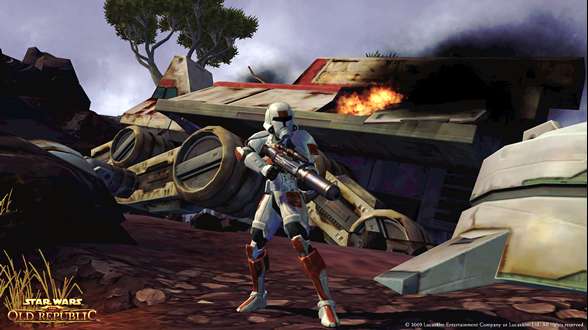
He did say, though, that they want the player to still be questing. “We want to make sure that the endgame isn’t completely different from what you’ve been doing. So there will be a natural progression… We want to make sure that when people play ToR they feel like they never run out of content, they always have something to do, that it’s an epic story.”
We get the impression that even if The Old Republic doesn’t tick all of our MMORPG boxes, if it feels a little weird to be chasing a personal story alongside thousands of others doing the same, it’ll still be a great BioWare game. We hope that’s their priority: we’re drowning in MMOs that ape the WoW template, and while plenty of them are nice enough, most of us are still waiting for something worth paying a monthly fee for. A Knights of the Old Republic with eight different stories, multiplayer conversations and near-limitless quests would certainly do it.
Source: Gamesradar

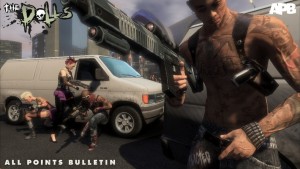

Pingback: Vladik
Pingback: http://%/bvwrteo